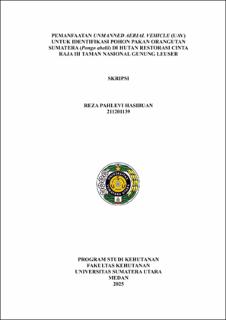Pemanfaatan Unmanned Aerial Vehicle (UAV) untuk Identifikasi Pohon Pakan Orangutan Sumatera (Pongo abelii) di Hutan Restorasi Cinta Raja III Taman Nasional Gunung Leuser
Utilization of Unmanned Aerial Vehicle (UAV) for the Identification of Feeding Trees for Sumatran Orangutans (Pongo abelii) at the Cinta Raja III Restoration Forest Gunung Leuser National Park

Date
2025Author
Hasibuan, Reza Pahlevi
Advisor(s)
Thoha, Achmad Siddik
Metadata
Show full item recordAbstract
Sumatran orangutans (Pongo abelii) are classified as critically endangered by the International Union for Conservation of Nature (IUCN). Food availability is a key factor for their survival, and efficient mapping of food trees using Unmanned Aerial Vehicles (UAVs) offers an important strategy for ecological research and conservation planning. This study aimed to map the distribution of orangutan food trees and assess species dominance in the Cinta Raja III Restoration Forest, Gunung Leuser National Park. The methodology involved processing aerial photographs into orthomosaics, followed by Object Based Image Analysis (OBIA). A total of 1,339 aerial images were captured at an altitude of 80 m and processed into an orthomosaic with a Ground Sampling Distance (GSD) of 2.09 cm/pixel, covering 28.12 ha. Twelve object classes were identified, including Adinobotrys atropurpureus, Cananga odorata, Elaeocarpus angustifolius, Macaranga gigantea, Macaranga hosei, Macaranga hypoleuca, Macaranga indica, Macaranga tanarius, non-vegetation, Syzygium polyanthum, non-food plants, and Vitex pinnata. Field surveys confirmed 20 orangutan food tree species, with Macaranga gigantea showing the highest Importance Value Index (IVI) of 42.77%. The species dominance aligned with OBIA classification at a segmentation scale of 100, yielding an overall accuracy of 82.78%. In contrast, Rubroshorea leprosula recorded the lowest IVI at 1.04%.
Collections
- Undergraduate Theses [2162]
